2001 NISSAN ALMERA N16 torque
[x] Cancel search: torquePage 1184 of 2493
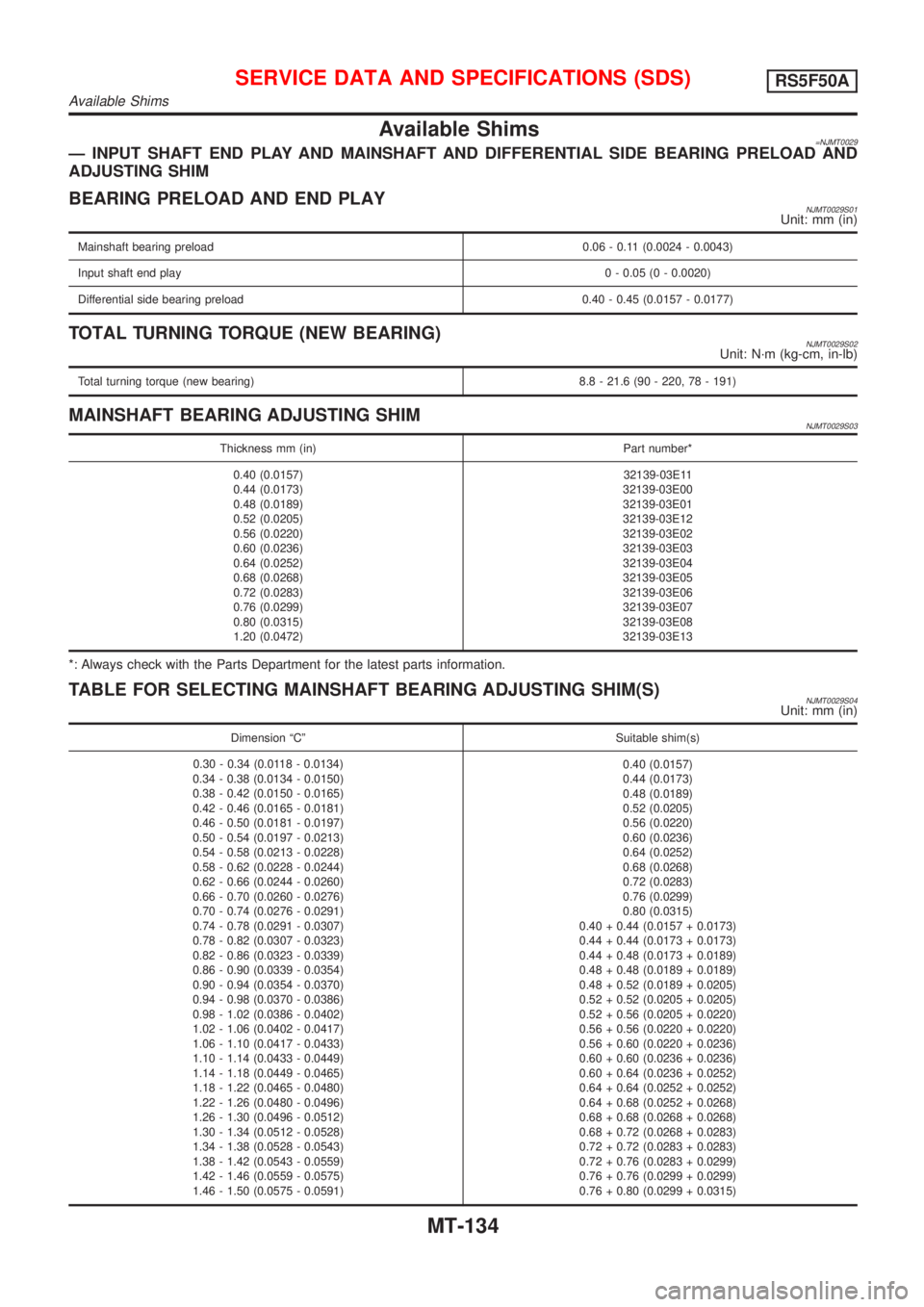
Available Shims=NJMT0029Ð INPUT SHAFT END PLAY AND MAINSHAFT AND DIFFERENTIAL SIDE BEARING PRELOAD AND
ADJUSTING SHIM
BEARING PRELOAD AND END PLAYNJMT0029S01Unit: mm (in)
Mainshaft bearing preload 0.06 - 0.11 (0.0024 - 0.0043)
Input shaft end play0 - 0.05 (0 - 0.0020)
Differential side bearing preload 0.40 - 0.45 (0.0157 - 0.0177)
TOTAL TURNING TORQUE (NEW BEARING)NJMT0029S02Unit: N´m (kg-cm, in-lb)
Total turning torque (new bearing) 8.8 - 21.6 (90 - 220, 78 - 191)
MAINSHAFT BEARING ADJUSTING SHIMNJMT0029S03
Thickness mm (in) Part number*
0.40 (0.0157)
0.44 (0.0173)
0.48 (0.0189)
0.52 (0.0205)
0.56 (0.0220)
0.60 (0.0236)
0.64 (0.0252)
0.68 (0.0268)
0.72 (0.0283)
0.76 (0.0299)
0.80 (0.0315)
1.20 (0.0472)32139-03E11
32139-03E00
32139-03E01
32139-03E12
32139-03E02
32139-03E03
32139-03E04
32139-03E05
32139-03E06
32139-03E07
32139-03E08
32139-03E13
*: Always check with the Parts Department for the latest parts information.
TABLE FOR SELECTING MAINSHAFT BEARING ADJUSTING SHIM(S)NJMT0029S04Unit: mm (in)
Dimension ªCº Suitable shim(s)
0.30 - 0.34 (0.0118 - 0.0134)
0.34 - 0.38 (0.0134 - 0.0150)
0.38 - 0.42 (0.0150 - 0.0165)
0.42 - 0.46 (0.0165 - 0.0181)
0.46 - 0.50 (0.0181 - 0.0197)
0.50 - 0.54 (0.0197 - 0.0213)
0.54 - 0.58 (0.0213 - 0.0228)
0.58 - 0.62 (0.0228 - 0.0244)
0.62 - 0.66 (0.0244 - 0.0260)
0.66 - 0.70 (0.0260 - 0.0276)
0.70 - 0.74 (0.0276 - 0.0291)
0.74 - 0.78 (0.0291 - 0.0307)
0.78 - 0.82 (0.0307 - 0.0323)
0.82 - 0.86 (0.0323 - 0.0339)
0.86 - 0.90 (0.0339 - 0.0354)
0.90 - 0.94 (0.0354 - 0.0370)
0.94 - 0.98 (0.0370 - 0.0386)
0.98 - 1.02 (0.0386 - 0.0402)
1.02 - 1.06 (0.0402 - 0.0417)
1.06 - 1.10 (0.0417 - 0.0433)
1.10 - 1.14 (0.0433 - 0.0449)
1.14 - 1.18 (0.0449 - 0.0465)
1.18 - 1.22 (0.0465 - 0.0480)
1.22 - 1.26 (0.0480 - 0.0496)
1.26 - 1.30 (0.0496 - 0.0512)
1.30 - 1.34 (0.0512 - 0.0528)
1.34 - 1.38 (0.0528 - 0.0543)
1.38 - 1.42 (0.0543 - 0.0559)
1.42 - 1.46 (0.0559 - 0.0575)
1.46 - 1.50 (0.0575 - 0.0591)0.40 (0.0157)
0.44 (0.0173)
0.48 (0.0189)
0.52 (0.0205)
0.56 (0.0220)
0.60 (0.0236)
0.64 (0.0252)
0.68 (0.0268)
0.72 (0.0283)
0.76 (0.0299)
0.80 (0.0315)
0.40 + 0.44 (0.0157 + 0.0173)
0.44 + 0.44 (0.0173 + 0.0173)
0.44 + 0.48 (0.0173 + 0.0189)
0.48 + 0.48 (0.0189 + 0.0189)
0.48 + 0.52 (0.0189 + 0.0205)
0.52 + 0.52 (0.0205 + 0.0205)
0.52 + 0.56 (0.0205 + 0.0220)
0.56 + 0.56 (0.0220 + 0.0220)
0.56 + 0.60 (0.0220 + 0.0236)
0.60 + 0.60 (0.0236 + 0.0236)
0.60 + 0.64 (0.0236 + 0.0252)
0.64 + 0.64 (0.0252 + 0.0252)
0.64 + 0.68 (0.0252 + 0.0268)
0.68 + 0.68 (0.0268 + 0.0268)
0.68 + 0.72 (0.0268 + 0.0283)
0.72 + 0.72 (0.0283 + 0.0283)
0.72 + 0.76 (0.0283 + 0.0299)
0.76 + 0.76 (0.0299 + 0.0299)
0.76 + 0.80 (0.0299 + 0.0315)
SERVICE DATA AND SPECIFICATIONS (SDS)RS5F50A
Available Shims
MT-134
Page 1188 of 2493
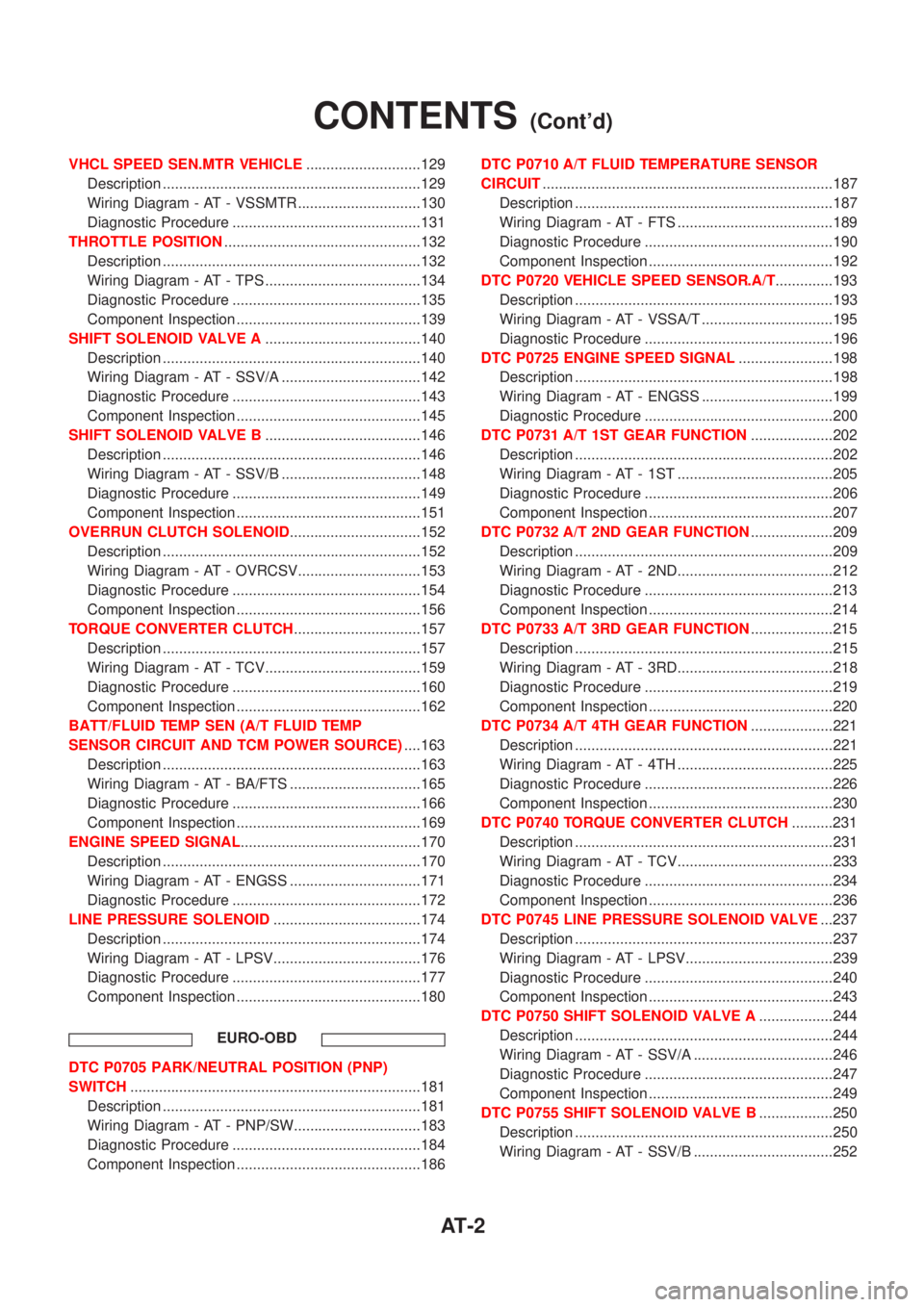
VHCL SPEED SEN.MTR VEHICLE............................129
Description ...............................................................129
Wiring Diagram - AT - VSSMTR ..............................130
Diagnostic Procedure ..............................................131
THROTTLE POSITION................................................132
Description ...............................................................132
Wiring Diagram - AT - TPS ......................................134
Diagnostic Procedure ..............................................135
Component Inspection .............................................139
SHIFT SOLENOID VALVE A......................................140
Description ...............................................................140
Wiring Diagram - AT - SSV/A ..................................142
Diagnostic Procedure ..............................................143
Component Inspection .............................................145
SHIFT SOLENOID VALVE B......................................146
Description ...............................................................146
Wiring Diagram - AT - SSV/B ..................................148
Diagnostic Procedure ..............................................149
Component Inspection .............................................151
OVERRUN CLUTCH SOLENOID................................152
Description ...............................................................152
Wiring Diagram - AT - OVRCSV..............................153
Diagnostic Procedure ..............................................154
Component Inspection .............................................156
TORQUE CONVERTER CLUTCH...............................157
Description ...............................................................157
Wiring Diagram - AT - TCV......................................159
Diagnostic Procedure ..............................................160
Component Inspection .............................................162
BATT/FLUID TEMP SEN (A/T FLUID TEMP
SENSOR CIRCUIT AND TCM POWER SOURCE)....163
Description ...............................................................163
Wiring Diagram - AT - BA/FTS ................................165
Diagnostic Procedure ..............................................166
Component Inspection .............................................169
ENGINE SPEED SIGNAL............................................170
Description ...............................................................170
Wiring Diagram - AT - ENGSS ................................171
Diagnostic Procedure ..............................................172
LINE PRESSURE SOLENOID....................................174
Description ...............................................................174
Wiring Diagram - AT - LPSV....................................176
Diagnostic Procedure ..............................................177
Component Inspection .............................................180
EURO-OBD
DTC P0705 PARK/NEUTRAL POSITION (PNP)
SWITCH.......................................................................181
Description ...............................................................181
Wiring Diagram - AT - PNP/SW...............................183
Diagnostic Procedure ..............................................184
Component Inspection .............................................186DTC P0710 A/T FLUID TEMPERATURE SENSOR
CIRCUIT.......................................................................187
Description ...............................................................187
Wiring Diagram - AT - FTS ......................................189
Diagnostic Procedure ..............................................190
Component Inspection .............................................192
DTC P0720 VEHICLE SPEED SENSOR.A/T..............193
Description ...............................................................193
Wiring Diagram - AT - VSSA/T ................................195
Diagnostic Procedure ..............................................196
DTC P0725 ENGINE SPEED SIGNAL.......................198
Description ...............................................................198
Wiring Diagram - AT - ENGSS ................................199
Diagnostic Procedure ..............................................200
DTC P0731 A/T 1ST GEAR FUNCTION....................202
Description ...............................................................202
Wiring Diagram - AT - 1ST ......................................205
Diagnostic Procedure ..............................................206
Component Inspection .............................................207
DTC P0732 A/T 2ND GEAR FUNCTION....................209
Description ...............................................................209
Wiring Diagram - AT - 2ND......................................212
Diagnostic Procedure ..............................................213
Component Inspection .............................................214
DTC P0733 A/T 3RD GEAR FUNCTION....................215
Description ...............................................................215
Wiring Diagram - AT - 3RD......................................218
Diagnostic Procedure ..............................................219
Component Inspection .............................................220
DTC P0734 A/T 4TH GEAR FUNCTION....................221
Description ...............................................................221
Wiring Diagram - AT - 4TH ......................................225
Diagnostic Procedure ..............................................226
Component Inspection .............................................230
DTC P0740 TORQUE CONVERTER CLUTCH..........231
Description ...............................................................231
Wiring Diagram - AT - TCV......................................233
Diagnostic Procedure ..............................................234
Component Inspection .............................................236
DTC P0745 LINE PRESSURE SOLENOID VALVE...237
Description ...............................................................237
Wiring Diagram - AT - LPSV....................................239
Diagnostic Procedure ..............................................240
Component Inspection .............................................243
DTC P0750 SHIFT SOLENOID VALVE A..................244
Description ...............................................................244
Wiring Diagram - AT - SSV/A ..................................246
Diagnostic Procedure ..............................................247
Component Inspection .............................................249
DTC P0755 SHIFT SOLENOID VALVE B..................250
Description ...............................................................250
Wiring Diagram - AT - SSV/B ..................................252
CONTENTS(Cont'd)
AT-2
Page 1195 of 2493
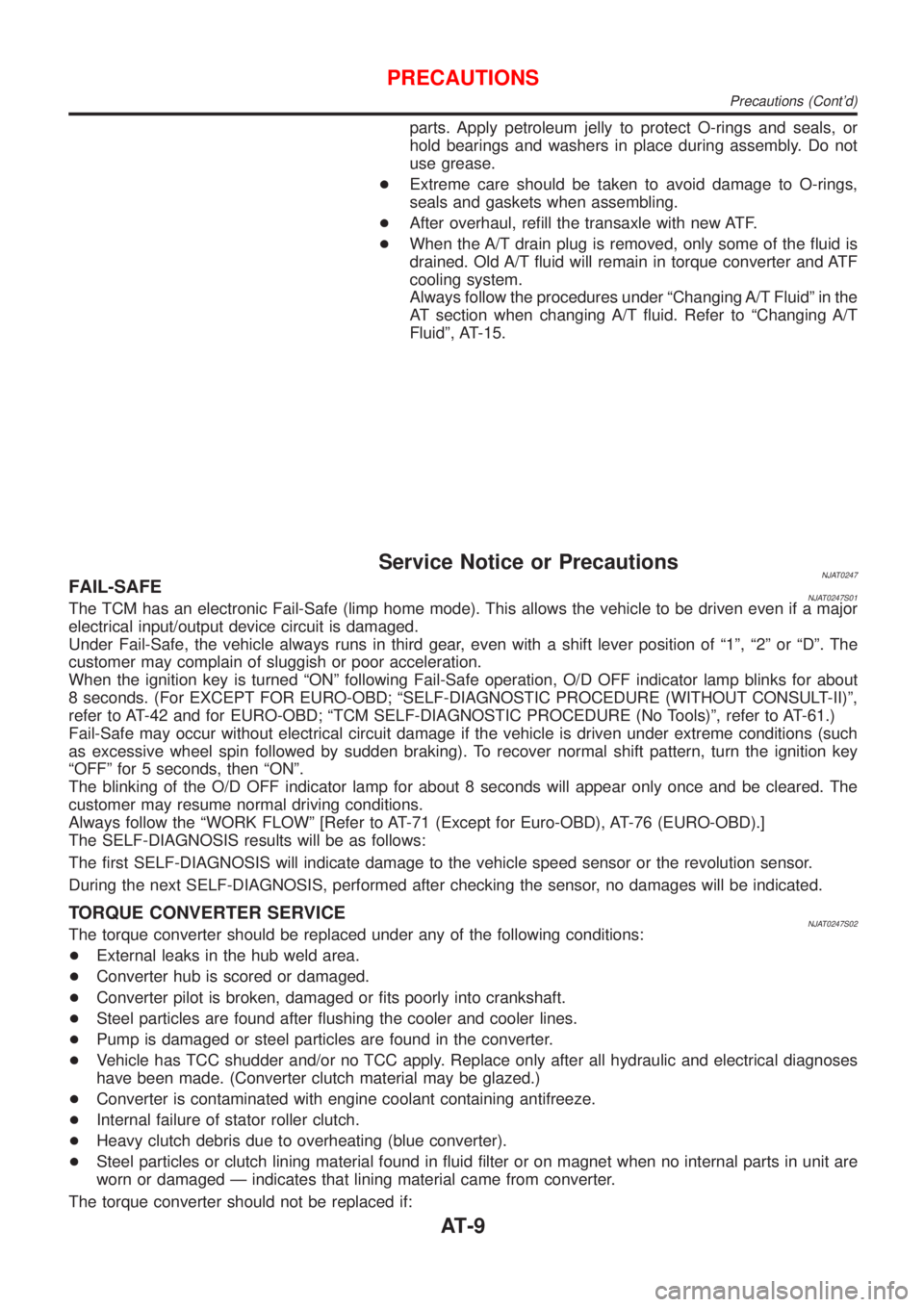
parts. Apply petroleum jelly to protect O-rings and seals, or
hold bearings and washers in place during assembly. Do not
use grease.
+Extreme care should be taken to avoid damage to O-rings,
seals and gaskets when assembling.
+After overhaul, refill the transaxle with new ATF.
+When the A/T drain plug is removed, only some of the fluid is
drained. Old A/T fluid will remain in torque converter and ATF
cooling system.
Always follow the procedures under ªChanging A/T Fluidº in the
AT section when changing A/T fluid. Refer to ªChanging A/T
Fluidº, AT-15.
Service Notice or PrecautionsNJAT0247FAIL-SAFENJAT0247S01The TCM has an electronic Fail-Safe (limp home mode). This allows the vehicle to be driven even if a major
electrical input/output device circuit is damaged.
Under Fail-Safe, the vehicle always runs in third gear, even with a shift lever position of ª1º, ª2º or ªDº. The
customer may complain of sluggish or poor acceleration.
When the ignition key is turned ªONº following Fail-Safe operation, O/D OFF indicator lamp blinks for about
8 seconds. (For EXCEPT FOR EURO-OBD; ªSELF-DIAGNOSTIC PROCEDURE (WITHOUT CONSULT-II)º,
refer to AT-42 and for EURO-OBD; ªTCM SELF-DIAGNOSTIC PROCEDURE (No Tools)º, refer to AT-61.)
Fail-Safe may occur without electrical circuit damage if the vehicle is driven under extreme conditions (such
as excessive wheel spin followed by sudden braking). To recover normal shift pattern, turn the ignition key
ªOFFº for 5 seconds, then ªONº.
The blinking of the O/D OFF indicator lamp for about 8 seconds will appear only once and be cleared. The
customer may resume normal driving conditions.
Always follow the ªWORK FLOWº [Refer to AT-71 (Except for Euro-OBD), AT-76 (EURO-OBD).]
The SELF-DIAGNOSIS results will be as follows:
The first SELF-DIAGNOSIS will indicate damage to the vehicle speed sensor or the revolution sensor.
During the next SELF-DIAGNOSIS, performed after checking the sensor, no damages will be indicated.
TORQUE CONVERTER SERVICENJAT0247S02The torque converter should be replaced under any of the following conditions:
+External leaks in the hub weld area.
+Converter hub is scored or damaged.
+Converter pilot is broken, damaged or fits poorly into crankshaft.
+Steel particles are found after flushing the cooler and cooler lines.
+Pump is damaged or steel particles are found in the converter.
+Vehicle has TCC shudder and/or no TCC apply. Replace only after all hydraulic and electrical diagnoses
have been made. (Converter clutch material may be glazed.)
+Converter is contaminated with engine coolant containing antifreeze.
+Internal failure of stator roller clutch.
+Heavy clutch debris due to overheating (blue converter).
+Steel particles or clutch lining material found in fluid filter or on magnet when no internal parts in unit are
worn or damaged Ð indicates that lining material came from converter.
The torque converter should not be replaced if:
PRECAUTIONS
Precautions (Cont'd)
AT-9
Page 1196 of 2493

+The fluid has an odor, is discolored, and there is no evidence of metal or clutch facing particles.
+The threads in one or more of the converter bolt holes are damaged.
+Transaxle failure did not display evidence of damaged or worn internal parts, steel particles or clutch plate
lining material in unit and inside the fluid filter.
+Vehicle has been exposed to high mileage (only). The exception may be where the torque converter clutch
dampener plate lining has seen excess wear by vehicles operated in heavy and/or constant traffic, such
as taxi, delivery or police use.
EURO-OBD SELF-DIAGNOSIS Ð EURO-OBD ÐNJAT0247S04+A/T self-diagnosis is performed by the TCM in combination with the ECM. The results can be read through
the blinking pattern of the O/D OFF indicator or the malfunction indicator (MI). Refer to the table on AT-53
for the indicator used to display each self-diagnostic result.
+The self-diagnostic results indicated by the MI are automatically stored in both the ECM and TCM memo-
ries.
Always perform the procedure ªHOW TO ERASE DTCº on AT-50 to complete the repair and avoid
unnecessary blinking of the MI.
+The following self-diagnostic items can be detected using ECM self-diagnostic results mode* only when
the O/D OFF indicator lamp does not indicate any malfunctions.
þ PNP switch
þ A/T 1st, 2nd, 3rd, or 4th gear function
*: For details of EURO-OBD, refer to EC-57, ªON BOARD DIAGNOSTIC SYSTEM DESCRIPTIONº.
+Certain systems and components, especially those related to EURO-OBD, may use a new style
slide-locking type harness connector.
For description and how to disconnect, refer to EL-5, ªHARNESS CONNECTORº.
Wiring Diagrams and Trouble DiagnosisNJAT0248When you read wiring diagrams, refer to the following:
+GI-12, ªHOW TO READ WIRING DIAGRAMSº
+EL-10, ªPOWER SUPPLY ROUTINGº
When you perform trouble diagnosis, refer to the following:
+GI-32, ªHOW TO FOLLOW TEST GROUP IN TROUBLE DIAGNOSISº
+GI-21, ªHOW TO PERFORM EFFICIENT DIAGNOSIS FOR AN ELECTRICAL INCIDENTº
PRECAUTIONS
Service Notice or Precautions (Cont'd)
AT-10
Page 1201 of 2493
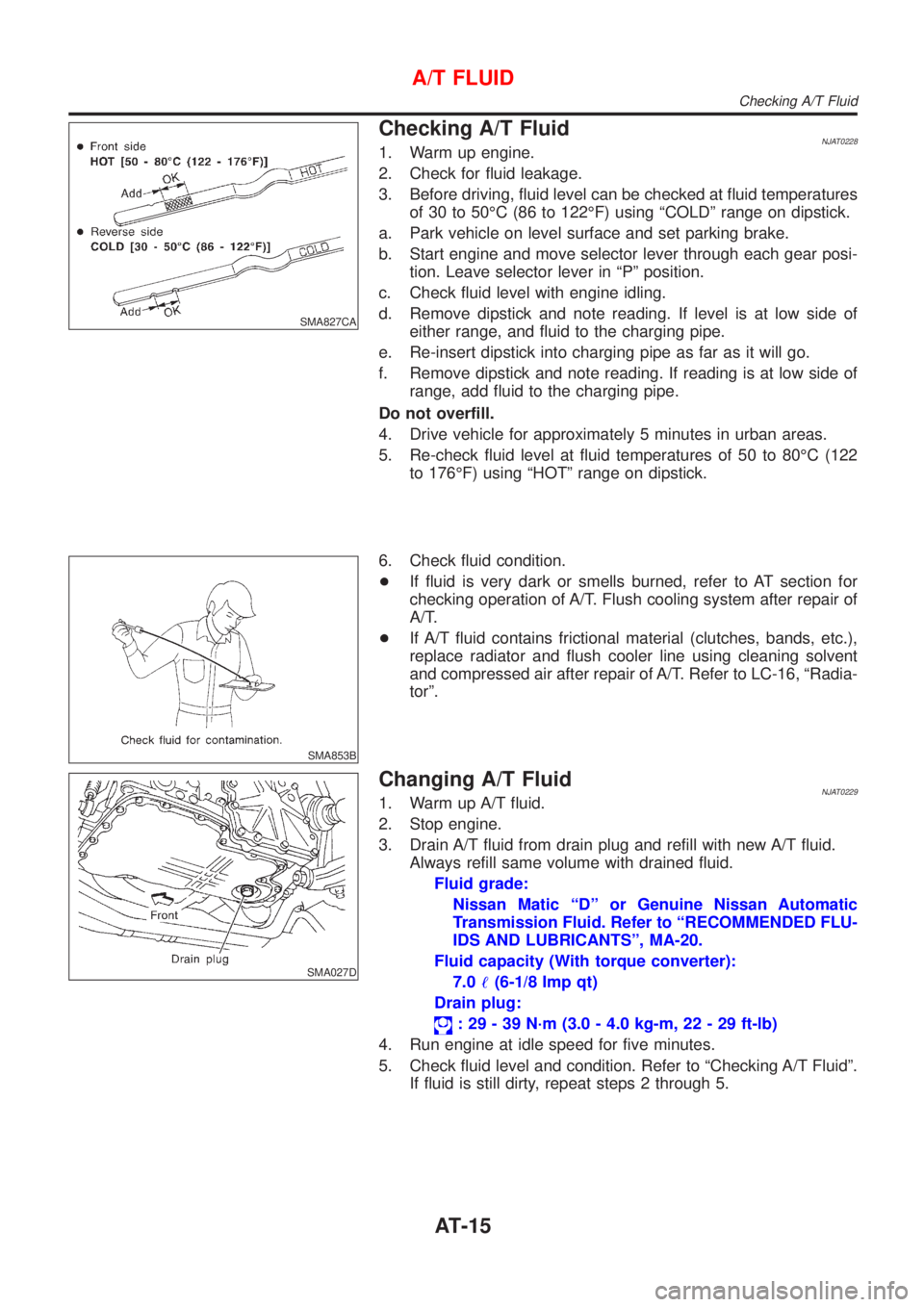
SMA827CA
Checking A/T FluidNJAT02281. Warm up engine.
2. Check for fluid leakage.
3. Before driving, fluid level can be checked at fluid temperatures
of 30 to 50ÉC (86 to 122ÉF) using ªCOLDº range on dipstick.
a. Park vehicle on level surface and set parking brake.
b. Start engine and move selector lever through each gear posi-
tion. Leave selector lever in ªPº position.
c. Check fluid level with engine idling.
d. Remove dipstick and note reading. If level is at low side of
either range, and fluid to the charging pipe.
e. Re-insert dipstick into charging pipe as far as it will go.
f. Remove dipstick and note reading. If reading is at low side of
range, add fluid to the charging pipe.
Do not overfill.
4. Drive vehicle for approximately 5 minutes in urban areas.
5. Re-check fluid level at fluid temperatures of 50 to 80ÉC (122
to 176ÉF) using ªHOTº range on dipstick.
SMA853B
6. Check fluid condition.
+If fluid is very dark or smells burned, refer to AT section for
checking operation of A/T. Flush cooling system after repair of
A/T.
+If A/T fluid contains frictional material (clutches, bands, etc.),
replace radiator and flush cooler line using cleaning solvent
and compressed air after repair of A/T. Refer to LC-16, ªRadia-
torº.
SMA027D
Changing A/T FluidNJAT02291. Warm up A/T fluid.
2. Stop engine.
3. Drain A/T fluid from drain plug and refill with new A/T fluid.
Always refill same volume with drained fluid.
Fluid grade:
Nissan Matic ªDº or Genuine Nissan Automatic
Transmission Fluid. Refer to ªRECOMMENDED FLU-
IDS AND LUBRICANTSº, MA-20.
Fluid capacity (With torque converter):
7.0!(6-1/8 Imp qt)
Drain plug:
: 29 - 39 N´m (3.0 - 4.0 kg-m, 22 - 29 ft-lb)
4. Run engine at idle speed for five minutes.
5. Check fluid level and condition. Refer to ªChecking A/T Fluidº.
If fluid is still dirty, repeat steps 2 through 5.
A/T FLUID
Checking A/T Fluid
AT-15
Page 1206 of 2493

Shift MechanismNJAT0013CONSTRUCTIONNJAT0013S01
SAT998I
1. Torque converter
2. Oil pump
3. Input shaft
4. Brake band
5. Reverse clutch
6. High clutch
7. Front sun gear
8. Front pinion gear9. Front internal gear
10. Front planetary carrier
11. Rear sun gear
12. Rear pinion gear
13. Rear internal gear
14. Rear planetary carrier
15. Forward clutch
16. Forward one-way clutch17. Overrun clutch
18. Low one-way clutch
19. Low & reverse brake
20. Parking pawl
21. Parking gear
22. Output shaft
23. Idle gear
24. Output gear
FUNCTION OF CLUTCH AND BRAKENJAT0013S03
Clutch and brake components Abbr. Function
5Reverse clutch R/C To transmit input power to front sun gear7.
6High clutch H/C To transmit input power to front planetary carrier10.
15Forward clutch F/C To connect front planetary carrier10with forward one-way clutch16.
17Overrun clutch O/C To connect front planetary carrier10with rear internal gear13.
4Brake band B/B To lock front sun gear7.
16Forward one-way clutch F/O.C When forward clutch15is engaged, to stop rear internal gear13from rotat-
ing in opposite direction against engine revolution.
18Low one-way clutch L/O.C To stop front planetary carrier10from rotating in opposite direction against
engine revolution.
19Low & reverse brake L & R/B To lock front planetary carrier10.
OVERALL SYSTEM
Shift Mechanism
AT-20
Page 1215 of 2493
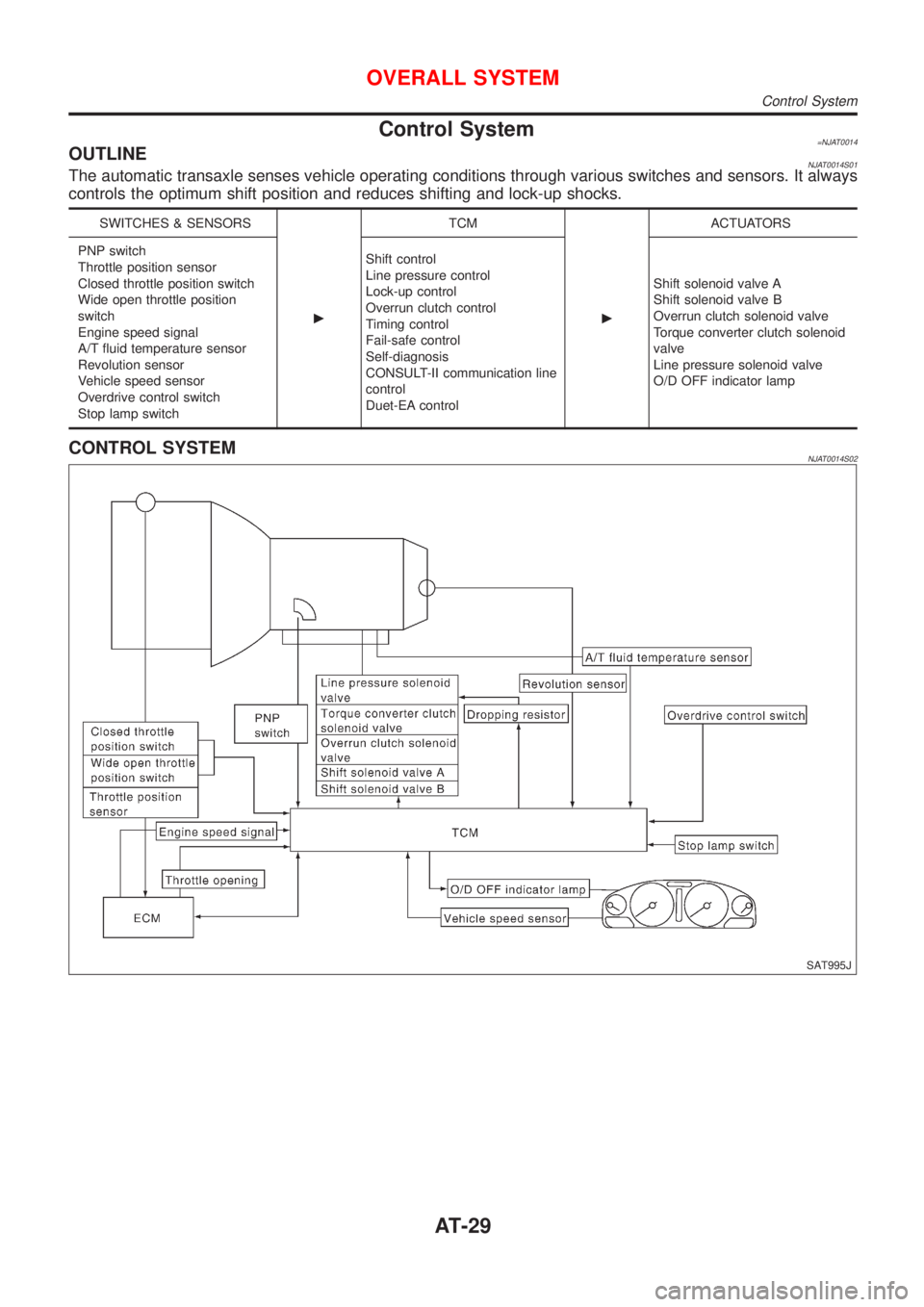
Control System=NJAT0014OUTLINENJAT0014S01The automatic transaxle senses vehicle operating conditions through various switches and sensors. It always
controls the optimum shift position and reduces shifting and lock-up shocks.
SWITCHES & SENSORS
cTCM
cACTUATORS
PNP switch
Throttle position sensor
Closed throttle position switch
Wide open throttle position
switch
Engine speed signal
A/T fluid temperature sensor
Revolution sensor
Vehicle speed sensor
Overdrive control switch
Stop lamp switchShift control
Line pressure control
Lock-up control
Overrun clutch control
Timing control
Fail-safe control
Self-diagnosis
CONSULT-II communication line
control
Duet-EA controlShift solenoid valve A
Shift solenoid valve B
Overrun clutch solenoid valve
Torque converter clutch solenoid
valve
Line pressure solenoid valve
O/D OFF indicator lamp
CONTROL SYSTEMNJAT0014S02
SAT995J
OVERALL SYSTEM
Control System
AT-29
Page 1216 of 2493
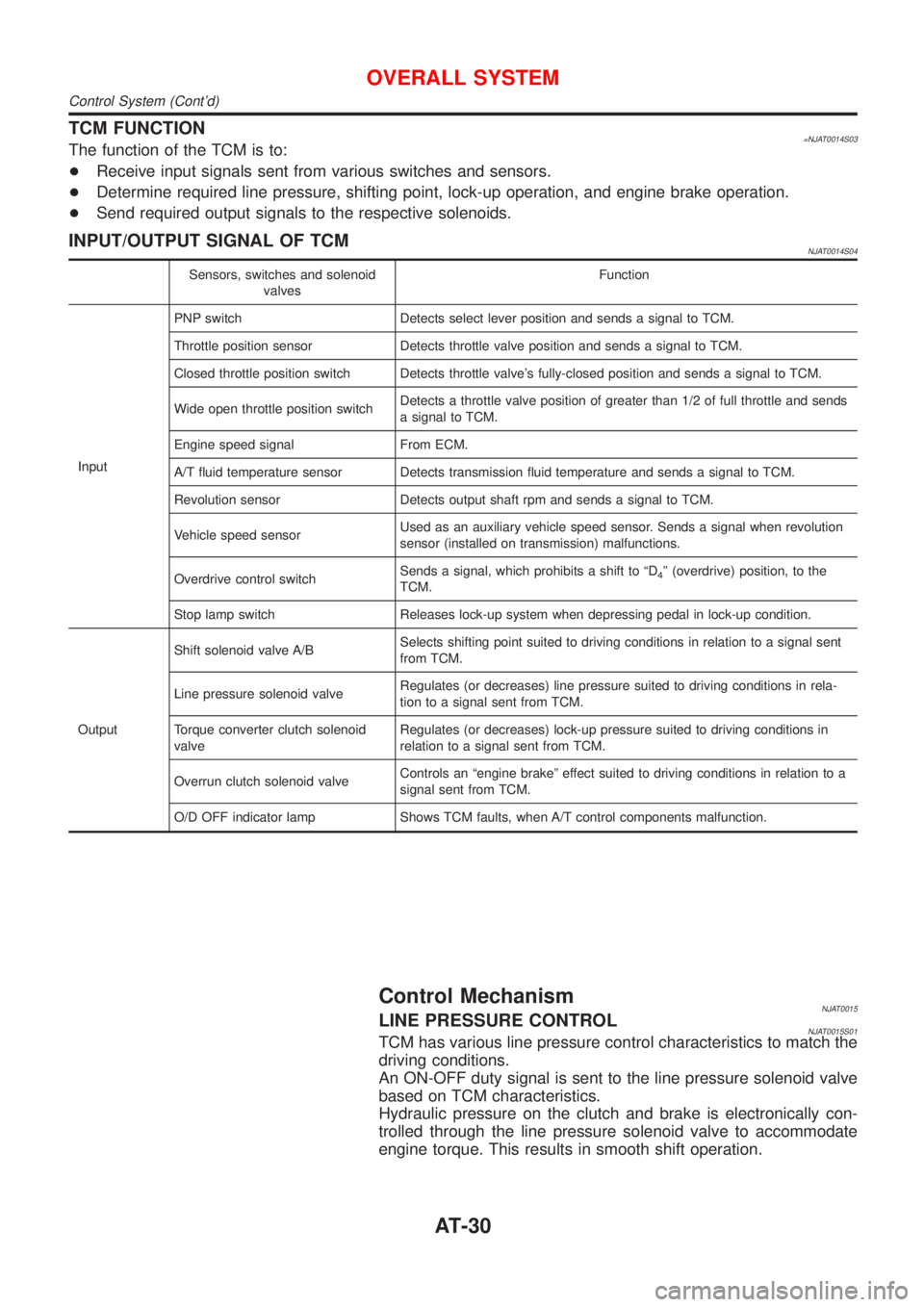
TCM FUNCTION=NJAT0014S03The function of the TCM is to:
+Receive input signals sent from various switches and sensors.
+Determine required line pressure, shifting point, lock-up operation, and engine brake operation.
+Send required output signals to the respective solenoids.
INPUT/OUTPUT SIGNAL OF TCMNJAT0014S04
Sensors, switches and solenoid
valvesFunction
InputPNP switch Detects select lever position and sends a signal to TCM.
Throttle position sensor Detects throttle valve position and sends a signal to TCM.
Closed throttle position switch Detects throttle valve's fully-closed position and sends a signal to TCM.
Wide open throttle position switchDetects a throttle valve position of greater than 1/2 of full throttle and sends
a signal to TCM.
Engine speed signal From ECM.
A/T fluid temperature sensor Detects transmission fluid temperature and sends a signal to TCM.
Revolution sensor Detects output shaft rpm and sends a signal to TCM.
Vehicle speed sensorUsed as an auxiliary vehicle speed sensor. Sends a signal when revolution
sensor (installed on transmission) malfunctions.
Overdrive control switchSends a signal, which prohibits a shift to ªD
4º (overdrive) position, to the
TCM.
Stop lamp switch Releases lock-up system when depressing pedal in lock-up condition.
OutputShift solenoid valve A/BSelects shifting point suited to driving conditions in relation to a signal sent
from TCM.
Line pressure solenoid valveRegulates (or decreases) line pressure suited to driving conditions in rela-
tion to a signal sent from TCM.
Torque converter clutch solenoid
valveRegulates (or decreases) lock-up pressure suited to driving conditions in
relation to a signal sent from TCM.
Overrun clutch solenoid valveControls an ªengine brakeº effect suited to driving conditions in relation to a
signal sent from TCM.
O/D OFF indicator lamp Shows TCM faults, when A/T control components malfunction.
Control MechanismNJAT0015LINE PRESSURE CONTROLNJAT0015S01TCM has various line pressure control characteristics to match the
driving conditions.
An ON-OFF duty signal is sent to the line pressure solenoid valve
based on TCM characteristics.
Hydraulic pressure on the clutch and brake is electronically con-
trolled through the line pressure solenoid valve to accommodate
engine torque. This results in smooth shift operation.
OVERALL SYSTEM
Control System (Cont'd)
AT-30